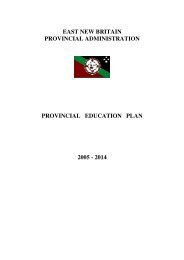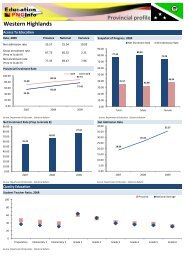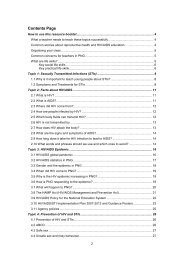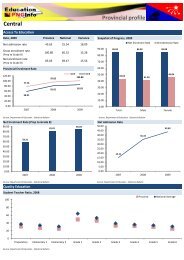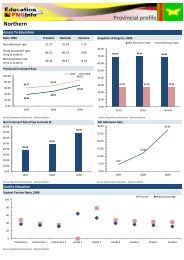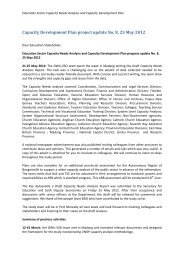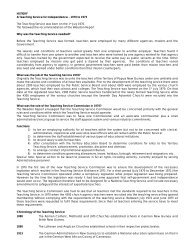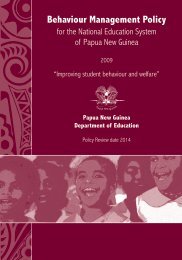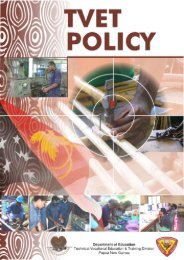Medium Term Development Plan, 2011-2015 - UNDP in Papua New ...
Medium Term Development Plan, 2011-2015 - UNDP in Papua New ...
Medium Term Development Plan, 2011-2015 - UNDP in Papua New ...
You also want an ePaper? Increase the reach of your titles
YUMPU automatically turns print PDFs into web optimized ePapers that Google loves.
5.13 Foreign aid<br />
Goal:<br />
Advanced stage of foreign aid management and ultimately atta<strong>in</strong> <strong>in</strong>dependence from foreign<br />
aid<br />
Introduction<br />
PNG still depends on foreign aid <strong>in</strong> areas such as transport and energy, telecommunication, health and<br />
education, food security and good governance. As prescribed <strong>in</strong> the PNGDSP, external aid can be viewed from<br />
two specific angles: resources for development programs such as health, education and transport; and<br />
technical expertise and skills to provide advisors and tra<strong>in</strong><strong>in</strong>g for deliver<strong>in</strong>g services and execut<strong>in</strong>g <strong>in</strong>vestment<br />
<strong>in</strong> development.<br />
The proportion of technical assistance to aid varies between development partners but the total percentage<br />
amongst all donors is estimated to be above 50 per cent which is considered to be too high. To reduce the<br />
dependence on foreign aid, PNG will need to drastically reduce the skills gap <strong>in</strong> the first five years, and<br />
simultaneously transfer the resources expended on technical assistance <strong>in</strong>to boost<strong>in</strong>g technical and higher<br />
education and tra<strong>in</strong><strong>in</strong>g, as well as <strong>in</strong>to the development of <strong>in</strong>frastructure.<br />
Over the next five years the level of technical assistance as a percentage of total foreign aid will decrease. In<br />
addition, the first MTDP <strong>in</strong>tends to significantly address aid effectiveness issues. Current weaknesses <strong>in</strong><br />
monitor<strong>in</strong>g and evaluation of <strong>in</strong>ternational aid underm<strong>in</strong>e efforts to improve its effectiveness. All assistance<br />
programs of donor partners will need to be aligned to support<strong>in</strong>g the realisation of the PNGDSP <strong>in</strong> a<br />
coord<strong>in</strong>ated and jo<strong>in</strong>t manner. In addition, an enabl<strong>in</strong>g environment will need to be established for PNG to<br />
graduate to a donor partner with<strong>in</strong> the Pacific region.<br />
MTDP <strong>2011</strong>-<strong>2015</strong><br />
As from <strong>2011</strong>, all foreign aid will need to comply fully with the PNGDSP and MTDP <strong>2011</strong>-<strong>2015</strong>. This will<br />
require radical change <strong>in</strong> the way donors operate <strong>in</strong> PNG, <strong>in</strong>clud<strong>in</strong>g a dramatic shift away from the focus on<br />
technical assistance for fill<strong>in</strong>g the skills gap. The new direction outl<strong>in</strong>ed <strong>in</strong> the PNGDSP, and to be<br />
implemented <strong>in</strong> the MTDP, is for all aid to be used to help fill the resources gap <strong>in</strong> the current and future<br />
MTDPs (see Part 7 for more details). This will mean technical assistance <strong>in</strong> its current form will largely be<br />
replaced by technical assistance required to implement the strategies of boost<strong>in</strong>g technical and higher<br />
education with<strong>in</strong> PNG, <strong>in</strong>clud<strong>in</strong>g implement<strong>in</strong>g short term tra<strong>in</strong><strong>in</strong>g programs. It will also mean a shift away<br />
from technical assistance and towards resourc<strong>in</strong>g projects <strong>in</strong> build<strong>in</strong>g <strong>in</strong>frastructure, <strong>in</strong>clud<strong>in</strong>g <strong>in</strong>frastructure<br />
<strong>in</strong> health and education.<br />
By <strong>2015</strong>, expected targets are: (a) less than 50 per cent of foreign aid will be for technical assistance, and<br />
most technical assistance will be <strong>in</strong> the areas of education and tra<strong>in</strong><strong>in</strong>g; (b) the total value of technical<br />
assistance <strong>in</strong> education and tra<strong>in</strong><strong>in</strong>g priority areas will <strong>in</strong>crease, with a correspond<strong>in</strong>g reduction <strong>in</strong> lower<br />
priority areas, and a greater utilisation of technical assistance from develop<strong>in</strong>g countries; (c) <strong>in</strong>creased<br />
number of scholarships and quality graduates <strong>in</strong> professions identified <strong>in</strong> the skills gap analysis, consistent<br />
with the national human resource requirements; (d) a national and sectoral dialogue system established and<br />
operationalised for development partners; (e) central and l<strong>in</strong>e agencies of the PNG Government to meet the<br />
pr<strong>in</strong>ciples of the Paris Declaration, the Accra Agenda for Action, and the PNG Commitments to Aid<br />
Effectiveness; (f) as an expression of a mature level of aid alignment to national development strategies, a<br />
s<strong>in</strong>gle Jo<strong>in</strong>t Assistance Strategy for PNG (JAS PNG) is adopted to complement the 2016-2020 MTDP, <strong>in</strong> place<br />
of <strong>in</strong>dividual country assistance strategies; (g) a significant and measurable reduction <strong>in</strong> aid fragmentation is<br />
achieved, and distribution of labour among development partners is agreed with the Government; (h) new<br />
modalities of aid and technical support are adopted, <strong>in</strong>clud<strong>in</strong>g the contract<strong>in</strong>g by the Government of<br />
development partners to produce specific developmental outcomes and the adoption of co-f<strong>in</strong>anc<strong>in</strong>g schemes;<br />
(i) South-South Cooperation agreements are negotiated, subscribed, and substantially implemented, with<br />
proper monitor<strong>in</strong>g and evaluation procedures to guarantee its value-for-money impact.<br />
In order to achieve these, the MTDP <strong>2011</strong>-<strong>2015</strong> will focus firstly on tak<strong>in</strong>g firm measures to:<br />
· undertake a comprehensive assessment of the skills gap and to establish — through partnership with<br />
donor partners — education, tra<strong>in</strong><strong>in</strong>g and scholarship programs to reduce this skills gap;<br />
· simultaneously undertake a sectoral analysis of technical assistance requirements and to redirect<br />
technical assistance away from low priority areas with a low education basis, to priority areas with<br />
capacity build<strong>in</strong>g through education and tra<strong>in</strong><strong>in</strong>g;<br />
· establish an advisory procurement and management system that is accountable to GoPNG systems;<br />
122



